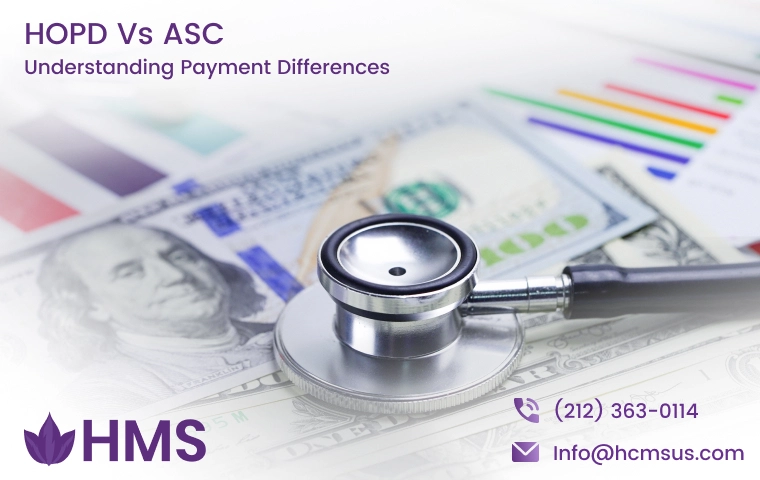The landscape of outpatient care offers patients a choice between hospital outpatient departments (HOPDs) and ambulatory surgery centers (ASCs). While both settings provide essential services, a crucial distinction lies in how they're reimbursed. This blog delves into the complexities of HOPD vs. ASC payment disparities and factors contributing to payment differences.
By understanding these differences, we can gain valuable insights into cost-effectiveness and navigate the outpatient care landscape more effectively.
What is HOPD?
HOPD stands for Hospital Outpatient Department. It's a department within a hospital that provides diagnostic and treatment services to patients who don't require an overnight stay. Think of it as a dedicated area within the hospital specifically designed for patients who can receive care and go home the same day. These services range from routine checkups and screenings to more complex procedures that don't require hospitalization.
What are ASCS?
ASC stands for Ambulatory Surgery Center. These are freestanding facilities specifically equipped to handle outpatient surgeries. Unlike HOPDs, ASCs are designed for procedures that are typically less complex and minimally invasive. Patients who undergo surgery at an ASC are discharged the same day, allowing for a quicker recovery in a more comfortable environment compared to a hospital setting.
Can An ASC Be Called an HOPD?
The answer might surprise you! While ASCs (Ambulatory Surgery Centers) and HOPDs (Hospital Outpatient Departments) seem like distinct entities, there can be some overlap based on regulations and financial ties.
Here's the key takeaway:
-
An ASC can technically be classified as an HOPD if it meets two specific criteria:
-
Location: The ASC must be within a 35-mile radius of the hospital.
-
Financial and Administrative Ties: The ASC must share the same financial and administrative contracts with the hospital.
-
Understanding the Payment Variance in HOPD Billing and ASCs Billing
patients often save money by receiving care in an ASC compared to an HOPD for the same procedure. The American Academy of Orthopaedic Surgeons (AAOS) highlights that "payment rates for the same procedures are lower in ASCs than in HOPDs." Studies show that Medicare reimburses procedures like knee arthroscopy, knee replacements, and fracture repairs at a significantly lower rate (around 53% less) when performed in an ASC compared to an HOPD.
These cost savings extend to physicians as well. Lower operating costs and potentially higher reimbursement rates in ASCs can translate to increased profit margins and physician income, depending on the specific procedures and patient volume.
The reason behind this payment variance boils down to the different payment systems used by each setting. HOPDs rely on the Outpatient Prospective Payment System (OPPS), while ASCs follow a separate fee schedule linked to, but distinct from, OPPS payments. This difference in methodology has a significant impact on reimbursement rates.
For example, under Medicare's OPPS, a diagnostic colonoscopy (CPT code 45378) performed in an HOPD setting might be reimbursed at $709.98. However, the same procedure performed in a freestanding ASC would be reimbursed at a much lower rate of $369.84 according to the ASC fee schedule (roughly 52% of the HOPD rate).
Key Differences in Payment and Regulations
|
Feature |
HOPD(Hospital Outpatient Department) |
ASC(Ambulatory Surgery Center) |
|
Payment System |
Outpatient Prospective Payment System (OPPS) |
ASC Fee Schedule (linked to, but not identical to, OPPS) |
|
Reimbursement Rates |
Generally higher |
Generally lower for the same procedure |
|
Cost Savings |
May be less cost-effective for patients |
May be more cost-effective for patients |
|
Regulations |
More stringent regulations |
Less stringent regulations compared to HOPDs |
|
Facility Type |
Located within a hospital |
Freestanding facility |
|
Complexity of Procedures |
Can handle a wider range of procedures, including more complex ones |
Typically handle less complex procedures |
|
Length of Stay |
Patients may be discharged on the same day or require an overnight stay |
Patients are typically discharged on the same day |
Three Key Players in the Payment Disparity
Now that we've established the significant cost savings associated with ASCs for patients, let's delve deeper into the factors behind the payment difference between ASCs and HOPDs.
Relative Weight:
Relative weight is the numerical value assigned to a service by CMS significantly impacts the final payment rate. Unfortunately, the calculation for ASCs gets a bit of a haircut. Due to adjustments within the OPPS system to maintain budget neutrality, the relative weight for the same service is often lower in the ASC setting compared to HOPDs. This translates to a lower starting point for determining the final payment in ASCs.
Conversion Factor:
Think of the conversion factor as a multiplier that takes the relative weight and transforms it into a dollar amount. Here's some good news for ASCs: The conversion factor for ASCs is now based on the hospital market basket, which promotes a more even playing field compared to the previous system based on the Consumer Price Index. However, the conversion factor for ASCs still remains lower than the one used for HOPDs. This means even with the more favorable market basket approach, ASCs generally start at a disadvantage.
Wage Index Adjustment:
Finally, we have the wage index adjustment. This factor considers the geographical differences in labor costs. Here's where things get a bit more nuanced. While both HOPDs and ASCs receive a wage index adjustment based on their location, the methodology differs slightly. Freestanding ASCs have 50% of their allowable rate adjusted based on the wage index, whereas HOPDs have 60% adjusted. This seemingly small difference can have a positive or negative impact on ASC payment rates depending on the specific wage index for their location.
Final Thoughts
Understanding the payment differences between HOPDs and ASCs empowers both patients and healthcare providers to make informed decisions. For patients, ASCs can offer a more cost-effective option for certain procedures. For healthcare providers, optimizing billing practices based on the facility setting (HOPD vs. ASC) can maximize revenue streams. While the payment landscape can be complex, staying informed allows for a more strategic approach to outpatient care.
ABOUT AUTHOR

John Wick
As a blog writer with years of experience in the healthcare industry, I have got what it takes to write well-researched content that adds value for the audience. I am a curious individual by nature, driven by passion and I translate that into my writings. I aspire to be among the leading content writers in the world.
